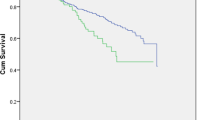Abstract
Objectives
Young patients with an ischaemic stroke or transient ischaemic attack (TIA) often have no vascular risk factors. Hyperhomocysteinaemia is an established risk factor for stroke in elderly patients but it is uncertain whether it is also important for the prognosis of young ischaemic stroke and TIA patients. We examined the possible effect of the plasma homocysteine level on the risk of recurrent vascular events in patients between 18 and 45 years of age.
Methods
The study population consisted of 161 consecutive patients with a recent cerebral infarction or TIA. Data on the primary event and the homocysteine level were collected retrospectively from hospital records. General practitioners and patients were contacted by telephone to record vascular events and the type of medication used during the follow–up period. Vascular events included cerebral infarction, TIA, pulmonary embolism, venous thrombosis, myocardial infarction and peripheral arterial disease.
Results
A Kaplan- Meier curve showed a dose effect relationship between event-free survival time and tertiles of the homocysteine level (Log rank statistic 5.91; p = 0.05). The Cox hazard ratio, after adjustment for homocysteine lowering treatment, was 1.7 (95 % CI, 1.1 to 2.8) for any vascular outcome event, 1.9 (95% CI, 1.1 to 3.0) for arterial outcome events and 1.8 (95 % CI, 1.1 to 2.9) for cerebral outcome events.
Conclusions
In spite of our small number of outcome events we found a significant association at the 95% confidence level between homocysteine level and the risk of recurrent vascular events in young patients with an ischaemic stroke or TIA. The association is of the same magnitude as in elderly people.
Similar content being viewed by others
References
Adams HPJ, Kappelle LJ, Biller J, Gordon DL, Love BB, Gomez F, et al. (1995) Ischemic stroke in young adults. Experience in 329 patients enrolled in the Iowa Registry of stroke in young adults. Arch Neurol 52:491–495
Berg BO (1989) Neurologic and diagnostic evaluation. In: Edwards MSB, Hoffman HJ (eds) Cerebro Vascular Disease in Children and Adolescents. Baltimore, Md: Williams and Wilkins, pp 47–67
Boushey CJ, Beresford SA, Omenn GS, Motulsky AG (1995) A quantitative assessment of plasma homocysteine as a risk factor for vascular disease. Probable benefits of increasing folic acid intakes. JAMA 274:1049–1057
Bots ML, Launer LJ, Lindemans J, Hoes AW, Hofman A, Witteman JC, et al. (1999) Homocysteine and short-term risk of myocardial infarction and stroke in the elderly: the Rotterdam Study. Arch Intern Med 159:38–44
Caplan ER, Estol C (1993) Stroke in children, adolescents, and young adults. In: Adams HPJ (ed) Handbook of cerebrovascular disease. New York, NY: Marcel Dekker Inc, pp 233–254
Del Ser T, Barba R, Herranz AS, Seijas V, Lopez-Manglano C, Domingo J, et al. (2001) Hyperhomocyst(e)inemia is a risk factor of secondary vascular events in stroke patients. Cerebrovasc Dis 12(2):91–98
Hart RG, Miller VT (1983) Cerebral infarction in young adults: a practical approach. Stroke 14:110–114
Perry IJ, Refsum H, Morris RW, Ebrahim SB, Ueland PM, Shaper AG (1995) Prospective study of serum total homocysteine concentration and risk of stroke in middle-aged British men. Lancet 346:1395–1398
Tan NC, Venketasubramanian N, Tjia HT (2002) Hyperhomocyst(e)inemia and Risk of Ischemic Stroke Among Young Asian Adults. Stroke 33:1956
Toole JF, Malinow MR, Chambless LE, Spence JD, Pettigrew LC, et al. (2004) Lowering Homocysteine in Patients With Ischemic Stroke to Prevent Recurrent Stroke,Myocardial Infarction, and Death: The Vitamin Intervention for Stroke Prevention (VISP) Randomized Controlled Trial. JAMA 291(5): 565–575
Vermeer SE, Dijk EJ v, Koudstaal PJ, Oudkerk M, Hofman A, Clarke R, et al. (2002) Homocysteine, Silent Brain Infarcts, and White Matter Lesions: The Rotterdam Scan Study. Ann Neurol 51:285–289
Vermeulen EG, Stehouwer CD, Twisk JW, van den Berg M, de Jong SC, Mackaay AJ, et al. (2000) Effect of homocysteine- lowering treatment with folic acid plus vitamin B6 on progression of subclinical atherosclerosis: a randomised, placebo-controlled trial. Lancet 355(9203):517–522
Welch GN, Loscalzo J (1998) Homocysteine and atherothrombosis. N Engl J Med 338:1042–1050
Adams HP Jr, Bendixen BH, Kappelle LJ, Biller J, Love BB, Gordon DL, Marsh EE 3rd (1993) Classification of subtype of acute ischemic stroke.Definitions for use in a multicenter clinical trial. TOAST. Trial of Org 10172 in Acute Stroke Treatment. Stroke. 24(1):35–41
Author information
Authors and Affiliations
Corresponding author
Rights and permissions
About this article
Cite this article
Bos, M.J., van Goor, ML.P.J., Koudstaal, P.J. et al. Plasma homocysteine is a risk factor for recurrent vascular events in young patients with an ischaemic stroke or TIA. J Neurol 252, 332–337 (2005). https://doi.org/10.1007/s00415-005-0647-9
Received:
Revised:
Accepted:
Published:
Issue Date:
DOI: https://doi.org/10.1007/s00415-005-0647-9




